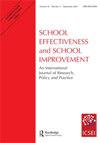差异、背景和不平等:印度两个邦学校效能模型的比较
IF 2.8
3区 教育学
Q1 EDUCATION & EDUCATIONAL RESEARCH
引用次数: 3
摘要
摘要:现有关于“学校效能”的研究表明,学校层面的差异对学生成绩的差异有显著影响;然而,人们对低收入和中等收入国家学校教育的有效性知之甚少。本文通过对印度两个邦的数据进行定量分析来解决这一差距。它比较了四个多层次的模型规范,以探索如何在印度背景下衡量学校表现。该分析揭示了巨大的“学校效应”,同时也提供了证据,证明学校之间的差异很大一部分源于学生的录取。研究结果表明,学校的“增值”模式可以更好地了解印度的学校表现和学习公平,并表明认识到模式规范的差异如何影响那些被认定为“更有效”的学校的重要性。本文章由计算机程序翻译,如有差异,请以英文原文为准。
Variation, context, and inequality: comparing models of school effectiveness in two states in India
ABSTRACT Existing research on “school effectiveness” indicates that differences at the school level contribute significantly towards variation in student outcomes; however, less is known about the effectiveness of schooling in low- and middle-income countries (LMICs). This paper addresses this gap using quantitative analysis of data from two states in India. It compares four multilevel model specifications to explore how school performance can be measured in the Indian context. The analysis reveals a large “school effect”, while also offering evidence that a considerable proportion of between-school variation stems from student intake. Findings suggest that school “value-added” models could offer better understanding of school performance and learning equity in India, and indicate the importance of recognising how differences in model specification affect those schools identified as “more effective”.
求助全文
通过发布文献求助,成功后即可免费获取论文全文。
去求助
来源期刊

School Effectiveness and School Improvement
EDUCATION & EDUCATIONAL RESEARCH-
CiteScore
6.60
自引率
0.00%
发文量
23
期刊介绍:
School Effectiveness and School Improvement presents information on educational effectiveness, practice and policy-making across primary, secondary and higher education. The Editors believe that the educational progress of all students, regardless of family background and economic status, is the key indicator of effectiveness and improvement in schools. The journal strives to explore this idea with manuscripts that cover a range of subjects within the area of educational effectiveness at the classroom, school or system level, including, but not limited to: •Effective pedagogy •Classroom climate •School ethos and leadership •School improvement and reform programmes •Systemwide policy and reform
 求助内容:
求助内容: 应助结果提醒方式:
应助结果提醒方式:


